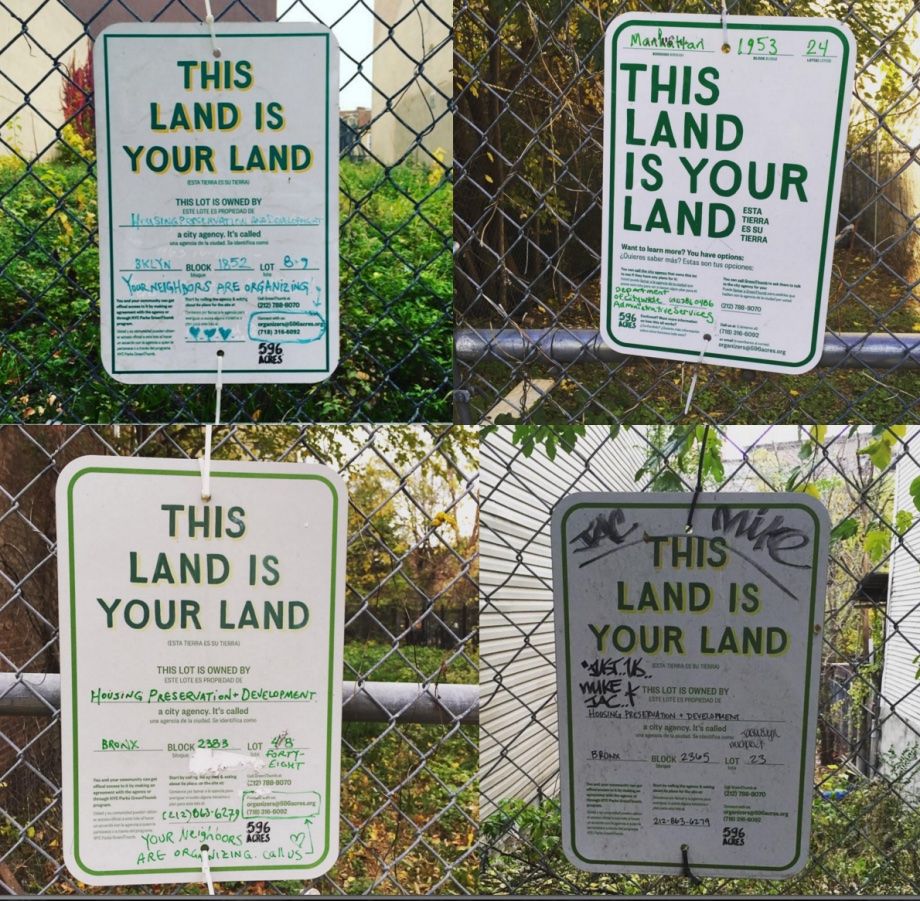“When we work in our community gardens,” said Kim Anderson, “we take back our fundamental right to work the land, and call a piece of earth our own, no matter how small. And we do it together.”
Anderson is one of a group of caretakers of the Eldert Street Garden in the Bushwick neighborhood of Brooklyn in New York. She helped establish the garden in 2009, and the community rooted in it has since grown to include vegetable plots, educational programming for kids and adults, composting, and more. In September, a new face appeared at the garden to serve the group eviction papers. They were one of three gardens to score legal victories against developers in a short span of November. The garden lives on, for now.
How do you turn each small victory into a movement? It’s a challenge for community activists everywhere, but such work is particularly critical in marginalized neighborhoods, places marked by decades of disillusionment and disconnect between residents and the people charged with representing, protecting and/or improving that place.
“Community activism is harder in marginalized neighborhoods because time, money and institutional memory are in short supply,” says Paula Segal, a lawyer and the director of 596 Acres, the Brooklyn-based community land access advocacy group behind those three victories.
The name, 596 Acres, refers to how much vacant, publicly owned land the NYC Department of City Planning perceived there to be in Brooklyn in 2011. Combing through public databases and surveying locations in person, they identified actual city-owned, vacant and unused lots that communities could potentially put to their own use. From there, the conversations began.
Sometimes, it starts with a sign. 596 Acres’ signs declaring “THIS LAND IS YOUR LAND” can now be found attached to chain-link fences or other structures throughout all of NYC, directing neighbors to call or email or use various other channels to tell 596 and/or their neighbors what has been happening on that vacant lot or what it could be used for.
Listening and documenting voicemails is a huge part of 596 Acres’ work. It’s part of the search for the existing institutional memory around each piece of land. Institutional memory can be an undervalued asset to make up for what marginalized communities might lack in terms of time or money.
“You have to have a way to maintain institutional memory to pick up things from where they’ve been left off. Energy rises and falls, groups change, people move in and out,” Segal says.
In the database 596 Acres built, called Living Lots NYC, there are 1428 sites of vacant, unused public land (807 acres); 43 sites of unused private land (18 acres; this includes vacant land available for community use being held by NYCHA and MTA, both of whom say they are “private” land owners); and 603 sites where communities have gained access for public use (32 sites, just over 8 acres, that have gotten access with 596 Acres’ help).
On each lot’s page, you can find information for who has jurisdiction over each lot and how to contact them, updates about what has happened at each lot, and contact information for community members interested in organizing around each lot’s future. Anyone with Internet access can create an update to ask a question or upload a photo of something going on at each lot. It’s the digitized institutional memory for that piece of community wealth.
Capturing and mapping neighborhood memory around community assets might be underutilized as a community activism tool, but it’s catching on. Since building Living Lots NYC, 596 Acres has since directly partnered or consulted with community organizers in Philadelphia, Los Angeles, New Orleans and Toronto so those cities could build their own versions. Others have taken 596 Acres’ community-led approach or software and built their own tools with minimal involvement from 596 Acres, such as in Montreal, Melbourne and Sydney.
“You can’t make it all work with a website. You might need a website to understand the situation so you can help the people that live in your city to solve problems,” Segal says. “But without a local advocacy organization the thing doesn’t work. All value of land in cities is socially created, so it should be socially shared as well instead of hoarded. The concentration of humans is what makes that land valuable in the first place. Humans should have a right to determining how that land is distributed and to be a beneficiary of that distribution.”
With that in mind, in April 2015, 596 Acres co-produced an initial education event that since has led to the creation of a facilitation team (of which Segal is a member), working groups and initial membership of the NYC Real Estate Investment Cooperative (NYCREIC). It’s grown to a group of over 300 New Yorkers (and counting) who are pooling their money and power to secure space for community, small business and cultural use in NYC. (The bylaws, governance structure and other aspects of NYCREIC are still under discussion.)
NYCREIC is not a 596 Acres program, or any one organization’s program, Segal is quick to emphasize. It’s new a way for every member to participate in deciding the future of their community.
“Otherwise we’re just continuing to consolidate wealth and consolidating power in the places we’re used to consolidating wealth and power,” she says.
The Equity Factor is made possible with the support of the Surdna Foundation.

Oscar is Next City's senior economic justice correspondent. He previously served as Next City’s editor from 2018-2019, and was a Next City Equitable Cities Fellow from 2015-2016. Since 2011, Oscar has covered community development finance, community banking, impact investing, economic development, housing and more for media outlets such as Shelterforce, B Magazine, Impact Alpha and Fast Company.
Follow Oscar .(JavaScript must be enabled to view this email address)

















